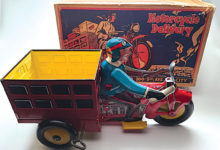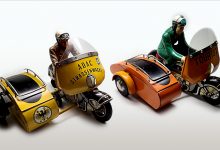O artigo desta semana irá familiarizar, resumidamente, o leitor com um dos fabricantes de brinquedos mais famosos do Japão, Toplay Kid., mais conhecido como T.P.S. Já discutimos a influência e perícia de vários países europeus que produziam brinquedos litografados. Os europeus eram famosos pelos movimentos mecânicos, os americanos comandavam o mercado de brinquedos de ferro fundido, e os japoneses dominavam o mercado dos brinquedos a pilhas.

O final da Segunda Guerra Mundial trouxe tempos difíceis ao Japão, primeiro com os eventos devastadores de 6 de agosto, de 1945, a aniquilação de Hiroshima e Nagasaki. Eventualmente, o Japão rendeu-se e foi ocupado pelos Aliados e, subsequentemente, proibido de se reorganizar militarmente. Como resultado, muitos dos engenheiros militares e fabricantes de armas tiveram de encontrar outras fontes de rendimento. Nesta altura, nasce a Indústria Japonesa de Brinquedos. Os brinquedos complexos de ação múltipla e, especialmente, operados a bateria foram desenhados, fabricados e distribuídos pelos quatro cantos do mundo. Sete anos mais tarde, a indústria das motas começou a florescer, rapidamente seguida dos automóveis, e depois dos eletrónicos… e o resto é história, para inventar uma frase.
Tokyo Plaything Shokai or T.P.S, é vastamente reconhecido como o primeiro fabricante japonês de brinquedos de 1950, 1960 e 1970. Inicialmente, a empresa começou a inundar a América do Norte nas lojas de 5 e 10 centavos com vários itens baratos embalados, principalmente anéis, amuletos, etc. Os brinquedos eram frequentemente muito coloridos, cómicos e geralmente fabricados para fazer as crianças sorrir.
A T.P.S. foi fundada em 1954 por Yoshio Udagawa, enquanto ainda trabalhava para a empresa de brinquedos Kokyu Shokai. Sentiu que estava na altura de começar a sua própria empresa e foi o que fez, em conjunto com um engenheiro experiente, chamado Yukio Miyakawa e um designer, Yasuo Kushida. Estes três indivíduos foram os fundadores e empregados do Tokyo Plaything Shokai. Nessa altura, o trio começou a desenhar e produzir os brinquedos mais únicos e interessantes que a indústria já tinha visto. Os seus designs únicos, cómicos, complexos e extravagantes capturaram a atenção e imaginação dos consumidores de brinquedos daquela época. Os seus brinquedos são muito procurados por colecionadores e os exemplares imaculados, em caixas, atingem preços altos.
O primeiro brinquedo produzido pela T.P.S. era o “Hobbo”, um palhaço com patins. Naquela altura, as novas ofertas eram um sucesso instantâneo, e a empresa foi imediatamente lançada para o estrelato. O brinquedo foi um sucesso tão grande que eventualmente superou um milhão de peças vendidas, nada mau para um lançamento! A minha coleção pessoal inclui os primeiros três brinquedos fabricados pela T.P.S. O segundo brinquedo era “Skippy the Tricky Cyclist” seguido do terceiro e mecanizado “Candy Loving Canine”. Na minha opinião, estas são peças históricas importantes para ilustrar o começo dos gigantes de brinquedos de hoje em dia, que ainda estão em negócio. Os grandes designs de brinquedos começam com grandes ideias, tanto o Sr. Udagawa como o seu designer apresentavam ideias, enquanto que o engenheiro, Sr. Miyakawa, projetava o mecanismo de ação. Eventualmente, todos estes processos transformavam-se em designs que seriam eventualmente utilizados para fabricar brinquedos.
O logotipo da T.P.S. é um símbolo figural que incorpora três dedos e um anel. O Sr. Udagawa indicou que o logo é um símbolo para representar as três pessoas que fundaram a empresa, juntos. Na sua opinião, a marca registada era totalmente simbólica tanto do nome da empresa como dos três fundadores da empresa.
Os seguintes exemplos são da minha coleção:
1950 – TPS “Hobo”, palhaço com patins. Primeiro brinquedo produzido pela empresa. Caixa original, sem reparos, cor intacta, roupas e funções. Condição C-10.
1950 – TPS, “Skippy the Tricky Cyclist”. Segundo brinquedo produzido pela empresa. Caixa original, sem reparos, litografia pura, cores vibrantes e funcional. Condição C-10.
1950 – TPS “Mechanical Candy Loving Canine”. Terceiro brinquedo produzido pela empresa. Sempre com fome, nunca satisfeito, doces originais, litografia brilhante, orelhas de borracha originais, funcionais. Condição C-10.
1950 – TPS Climbing Pirate, puxe meu anel e veja os meus gráficos em escalada. Caixa original, sem reparos, litografia brilhante e recibo original, 13 de abril de 1960; 79 ¢ mais impostos, 2¢.
Joy from Japan
This week’s article will briefly familiarize the reader with one of Japan’s most famous toy manufacturers, Toplay Ltd., most commonly known and identified as T.P.S. We have already discussed the influence and expertise of several European countries who produced lithographed toys. The Europeans were famous for mechanical movements, the Americans ruled the cast iron toy market, and the Japanese ruled the battery-operated toy market.

The end of the Second World War brought many hardships for Japan, firstly the devastating events of August 6, 1945 to August 9, 1945, the annihilation of Hiroshima and Nagasaki. Eventually, Japan surrendered and was occupied by the allies and subsequently forbidden from any military reorganization. As a result, many of those previous serving military engineers and fabricators of weapons of war had to find other sources of employment. At this time, the Japanese Toy Industry was born. Complicated multi action wind up and especially battery-operated toys were designed, manufactured, and distributed to all four corners of the world. Several years later, the motorcycle industry began to flourish, quickly followed by automobiles, followed by electronics…and the rest is history, to coin a phrase.
Tokyo Plaything Shokai or T.P.S., is widely recognized as the premier Japanese toy manufacturer of the 1950’s, 1060’s, and 1970’s. The company initially started flooding the North American 5¢ and 10¢ dime stores with cheaply made multi packed items, primarily rings, charms, etc. The toys were often very colorful, comical, and generally manufactured to make kids smile.
T.P.S. was founded in 1954 by Yoshio Udagawa, while he was still working for the Kokyu Shokai Toy Company. He felt that it was time for him to start his own company and he did just that along with a very experienced engineer, name Yukio Miyakawa, and a designer, Yasuo Kushida. These three individuals were the original founders and employees of Tokyo Plaything Shokai. At this time, the trio began to design and produce the most unique and interesting toy designs that had ever been seen in the industry. Their unique comical, complex, and whimsical designs captured the complete attention and imagination of commercial toy buyers of the era. Their toys are highly sought after by today’s collector and pristine boxed examples, command top prices.
The very first toy produced by T.P.S. was the “Hobo”, a clown on roller skates. At that time, new offering was an instant success, and the new company was immediately launched into stardom. The toy was so successful that it eventually sold over one million pieces, not bad for a launch! My personal collection includes the first three toys to have been manufactured by T.P.S. The second toy was “Skippy the Tricky Cyclist” followed by the third and mechanical “Candy Loving Canine”. In my opinion, these are important historical pieces to illustrate the beginning of a modern-day toy giant, which subsequently is still in business. Great toy designs begin with great ideas, both Mr. Udagawa and his designer would come up with ideas, while the engineer, Mr. Miyakawa would engineer the action mechanism. Eventually all these processes were turned into designs, which would eventually be used to manufacture toys.
The T.P.S. logo is a figural symbol which incorporates three fingers and a lower ring band. Mr. Udagawa indicates that the logo is a symbol to represent the three original people which founded the company, together. In his opinion, the trademark was wholly symbolic of both the company namesake and the original three co-founders of the company.
The following examples are from my collection.
1950’s – TPS “Hobo”, clown on roller skates. First toy ever produced by the company. Original box, no repairs, pristine colour, clothing and function. C-10 Condition.
1950’s – TPS, “Skippy the Tricky Cyclist”. Second toy ever produced by the company. Original box, no repairs, pristine lithography, vibrant colors, and functional. C-10 Condition.
1950’s – TPS “Mechanical Candy Loving Canine”. Third toy produced by the company. Always hungry, never satisfied, original candy pellets, bright lithography, original rubber ears, functional. C-10 Condition.
1950’s – TPS Climbing Pirate, pull my ring and see my climb graphics. Original box, no repairs, bright lithography, and original receipt, 13th of April 1960; 79¢ plus tax, 2¢.








Redes Sociais - Comentários